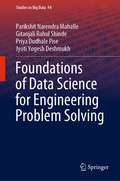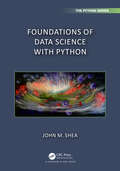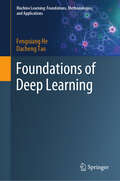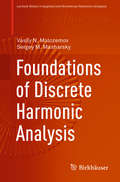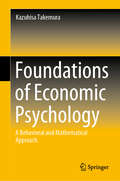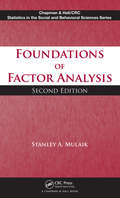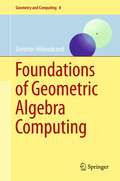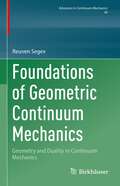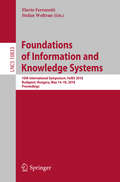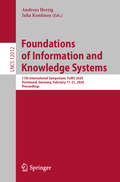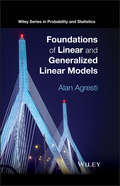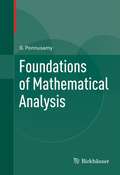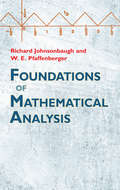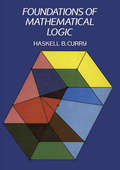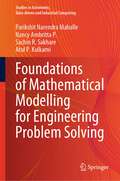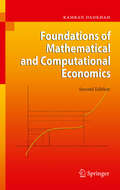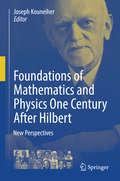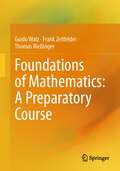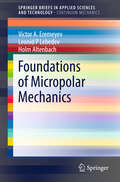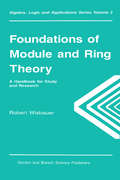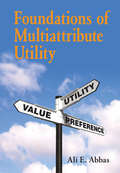- Table View
- List View
Foundations of Data Science for Engineering Problem Solving (Studies in Big Data #94)
by Gitanjali Rahul Shinde Parikshit Narendra Mahalle Priya Dudhale Pise Jyoti Yogesh DeshmukhThis book is one-stop shop which offers essential information one must know and can implement in real-time business expansions to solve engineering problems in various disciplines. It will also help us to make future predictions and decisions using AI algorithms for engineering problems. Machine learning and optimizing techniques provide strong insights into novice users. In the era of big data, there is a need to deal with data science problems in multidisciplinary perspective. In the real world, data comes from various use cases, and there is a need of source specific data science models. Information is drawn from various platforms, channels, and sectors including web-based media, online business locales, medical services studies, and Internet. To understand the trends in the market, data science can take us through various scenarios. It takes help of artificial intelligence and machine learning techniques to design and optimize the algorithms. Big data modelling and visualization techniques of collected data play a vital role in the field of data science. This book targets the researchers from areas of artificial intelligence, machine learning, data science and big data analytics to look for new techniques in business analytics and applications of artificial intelligence in recent businesses.
Foundations of Data Science with Python (Chapman & Hall/CRC The Python Series)
by John M. SheaFoundations of Data Science with Python introduces readers to the fundamentals of data science, including data manipulation and visualization, probability, statistics, and dimensionality reduction. This book is targeted toward engineers and scientists, but it should be readily understandable to anyone who knows basic calculus and the essentials of computer programming. It uses a computational-first approach to data science: the reader will learn how to use Python and the associated data-science libraries to visualize, transform, and model data, as well as how to conduct statistical tests using real data sets. Rather than relying on obscure formulas that only apply to very specific statistical tests, this book teaches readers how to perform statistical tests via resampling; this is a simple and general approach to conducting statistical tests using simulations that draw samples from the data being analyzed. The statistical techniques and tools are explained and demonstrated using a diverse collection of data sets to conduct statistical tests related to contemporary topics, from the effects of socioeconomic factors on the spread of the COVID-19 virus to the impact of state laws on firearms mortality.This book can be used as an undergraduate textbook for an Introduction to Data Science course or to provide a more contemporary approach in courses like Engineering Statistics. However, it is also intended to be accessible to practicing engineers and scientists who need to gain foundational knowledge of data science.Key Features: Applies a modern, computational approach to working with data Uses real data sets to conduct statistical tests that address a diverse set of contemporary issues Teaches the fundamentals of some of the most important tools in the Python data-science stack Provides a basic, but rigorous, introduction to Probability and its application to Statistics Offers an accompanying website that provides a unique set of online, interactive tools to help the reader learn the material
Foundations of Data Visualization
by Min Chen Helwig Hauser Penny Rheingans Gerik ScheuermannThis is the first book that focuses entirely on the fundamental questions in visualization. Unlike other existing books in the field, it contains discussions that go far beyond individual visual representations and individual visualization algorithms. It offers a collection of investigative discourses that probe these questions from different perspectives, including concepts that help frame these questions and their potential answers, mathematical methods that underpin the scientific reasoning of these questions, empirical methods that facilitate the validation and falsification of potential answers, and case studies that stimulate hypotheses about potential answers while providing practical evidence for such hypotheses. Readers are not instructed to follow a specific theory, but their attention is brought to a broad range of schools of thoughts and different ways of investigating fundamental questions. As such, the book represents the by now most significant collective effort for gathering a large collection of discourses on the foundation of data visualization. Data visualization is a relatively young scientific discipline. Over the last three decades, a large collection of computer-supported visualization techniques have been developed, and the merits and benefits of using these techniques have been evidenced by numerous applications in practice. These technical advancements have given rise to the scientific curiosity about some fundamental questions such as why and how visualization works, when it is useful or effective and when it is not, what are the primary factors affecting its usefulness and effectiveness, and so on. This book signifies timely and exciting opportunities to answer such fundamental questions by building on the wealth of knowledge and experience accumulated in developing and deploying visualization technology in practice.
Foundations of Deep Learning (Machine Learning: Foundations, Methodologies, and Applications)
by Dacheng Tao Fengxiang HeDeep learning has significantly reshaped a variety of technologies, such as image processing, natural language processing, and audio processing. The excellent generalizability of deep learning is like a “cloud” to conventional complexity-based learning theory: the over-parameterization of deep learning makes almost all existing tools vacuous. This irreconciliation considerably undermines the confidence of deploying deep learning to security-critical areas, including autonomous vehicles and medical diagnosis, where small algorithmic mistakes can lead to fatal disasters. This book seeks to explaining the excellent generalizability, including generalization analysis via the size-independent complexity measures, the role of optimization in understanding the generalizability, and the relationship between generalizability and ethical/security issues. The efforts to understand the excellent generalizability are following two major paths: (1) developing size-independent complexity measures, which can evaluate the “effective” hypothesis complexity that can be learned, instead of the whole hypothesis space; and (2) modelling the learned hypothesis through stochastic gradient methods, the dominant optimizers in deep learning, via stochastic differential functions and the geometry of the associated loss functions. Related works discover that over-parameterization surprisingly bring many good properties to the loss functions. Rising concerns of deep learning are seen on the ethical and security issues, including privacy preservation and adversarial robustness. Related works also reveal an interplay between them and generalizability: a good generalizability usually means a good privacy-preserving ability; and more robust algorithms might have a worse generalizability. We expect readers can have a big picture of the current knowledge in deep learning theory, understand how the deep learning theory can guide new algorithm designing, and identify future research directions. Readers need knowledge of calculus, linear algebra, probability, statistics, and statistical learning theory.
Foundations of Discrete Harmonic Analysis (Applied and Numerical Harmonic Analysis)
by Vasily N. Malozemov Sergey M. MasharskyThis book provides an introduction to discrete harmonic analysis (DHA) with a view towards applications to digital signal processing. In a nutshell, DHA is used to determine the time-frequency structure of a digitized signal, providing a representation of the signal as a sum of spectral components that can then be analyzed.The main methods of DHA are discrete Fourier transform and other discrete orthogonal transforms such as the Walsh and Haar transforms. Fast algorithms are used to process signals in real time, while additional options are provided by spline harmonic analysis. These topics are carefully covered in the book. With only modest prerequisites, some of which are recalled at the beginning, a profound mathematical theory is built almost from scratch. The 150 exercises included form an integral part of the text.Based decades of teaching experience, this book provides a basis for lecture courses starting at the upper undergraduate level, and will also prove a valuable resource for mathematicians and engineers interested in digital signal processing.
Foundations of Dynamic Economic Analysis
by Michael R. CaputoPresenting a thorough introductory exposition of optimal control theory, this work differs from the existing textbooks on the subject due to its emphasis on the economic interpretation of the mathematics and the qualitative properties of the solutions. Moreover, it is a modern exposition of optimal control theory in that it presents numerous complementary methods. It is aimed at first-year and second-year PhD students in economics, agricultural and resource economics, operations research, management science, and applied mathematics.
Foundations of Economic Psychology: A Behavioral and Mathematical Approach
by Kazuhisa TakemuraThis book provides an overview of the concept of economic psychology from behavioral and mathematical perspectives and related theoretical and empirical findings. Economic psychology is defined briefly as a general term for descriptive theories to explain the psychological processes of microeconomic behaviors and macroeconomic phenomena. However, the psychological methodology and knowledge of economic psychology have also been applied widely in such fields as economics, business administration, and engineering, and they are expected to become increasingly useful in the future—a trend suggested in several eminent scholars’ studies.The book explains the numerous behavioral and mathematical models of economic psychology related to micro- and macroeconomic phenomena that have been proposed in the past, and introduces new models that are useful to explain human economic behaviors. It concludes with speculations about the future of modern economic psychology, referring to its connection with fields related to neuroscience, such as neuroeconomics, which have been developed in recent years.Readers require no advanced expertise; nonetheless, an introductory understanding of psychology, business administration, and economics, and a high- school-graduate level of mathematics are useful. To aid readers, each chapter includes a bibliography, which can be referred for more details related to economic psychology.
Foundations of Ergodic Theory
by Marcelo Viana Krerley OliveiraRich with examples and applications, this textbook provides a coherent and self-contained introduction to ergodic theory, suitable for a variety of one- or two-semester courses. The authors' clear and fluent exposition helps the reader to grasp quickly the most important ideas of the theory, and their use of concrete examples illustrates these ideas and puts the results into perspective. The book requires few prerequisites, with background material supplied in the appendix. The first four chapters cover elementary material suitable for undergraduate students – invariance, recurrence and ergodicity – as well as some of the main examples. The authors then gradually build up to more sophisticated topics, including correlations, equivalent systems, entropy, the variational principle and thermodynamical formalism. The 400 exercises increase in difficulty through the text and test the reader's understanding of the whole theory. Hints and solutions are provided at the end of the book.
Foundations of Factor Analysis (Chapman & Hall/CRC Statistics in the Social and Behavioral Sciences)
by Stanley A MulaikProviding a practical, thorough understanding of how factor analysis works, Foundations of Factor Analysis, Second Edition discusses the assumptions underlying the equations and procedures of this method. It also explains the options in commercial computer programs for performing factor analysis and structural equation modeling. This long-awaited e
Foundations of Geometric Algebra Computing
by Dietmar HildenbrandThe author defines "Geometric Algebra Computing" as the geometrically intuitive development of algorithms using geometric algebra with a focus on their efficient implementation, and the goal of this book is to lay the foundations for the widespread use of geometric algebra as a powerful, intuitive mathematical language for engineering applications in academia and industry. The related technology is driven by the invention of conformal geometric algebra as a 5D extension of the 4D projective geometric algebra and by the recent progress in parallel processing, and with the specific conformal geometric algebra there is a growing community in recent years applying geometric algebra to applications in computer vision, computer graphics, and robotics. This book is organized into three parts: in Part I the author focuses on the mathematical foundations; in Part II he explains the interactive handling of geometric algebra; and in Part III he deals with computing technology for high-performance implementations based on geometric algebra as a domain-specific language in standard programming languages such as C++ and OpenCL. The book is written in a tutorial style and readers should gain experience with the associated freely available software packages and applications. The book is suitable for students, engineers, and researchers in computer science, computational engineering, and mathematics.
Foundations of Geometric Continuum Mechanics: Geometry and Duality in Continuum Mechanics (Advances in Mechanics and Mathematics #49)
by Reuven SegevThis monograph presents the geometric foundations of continuum mechanics. An emphasis is placed on increasing the generality and elegance of the theory by scrutinizing the relationship between the physical aspects and the mathematical notions used in its formulation. The theory of uniform fluxes in affine spaces is covered first, followed by the smooth theory on differentiable manifolds, and ends with the non-smooth global theory. Because continuum mechanics provides the theoretical foundations for disciplines like fluid dynamics and stress analysis, the author’s extension of the theory will enable researchers to better describe the mechanics of modern materials and biological tissues. The global approach to continuum mechanics also enables the formulation and solutions of practical optimization problems.Foundations of Geometric Continuum Mechanics will be an invaluable resource for researchers in the area, particularly mathematicians, physicists, and engineers interested in the foundational notions of continuum mechanics.
Foundations of Information and Knowledge Systems: 10th International Symposium, Foiks 2018, Budapest, Hungary, May 14-18, 2018, Proceedings (Lecture Notes in Computer Science #10833)
by Flavio Ferrarotti Stefan WoltranThis book constitutes the refereed proceedings of the 10th International Symposium on Foundations of Information and Knowledge Systems, FoIKS 2018, held in Budapest, Hungary, in May 2018.The 20 revised full papers presented together with 1 invited talk were carefully reviewed and selected from 40 submissions. The papers address various topics such as big data; database design; dynamics of information; information fusion; integrity and constraint management; intelligent agents; knowledge discovery and information retrieval; knowledge representation, reasoning and planning; logics in databases and AI; mathematical foundations; security in information and knowledge systems; semi-structured data and XML; social computing; the semantic web and knowledge management; and the world wide web.
Foundations of Information and Knowledge Systems: 11th International Symposium, FoIKS 2020, Dortmund, Germany, February 17–21, 2020, Proceedings (Lecture Notes in Computer Science #12012)
by Andreas Herzig Juha KontinenThis book constitutes the refereed proceedings of the 11th International Symposium on Foundations of Information and Knowledge Systems, FoIKS 2020, held in Dortmund, Germany, in February 2020.The 19 revised full papers presented were carefully reviewed and selected from 33 submissions. The papers address various topics such as big data; database design; dynamics of information; information fusion; integrity and constraint management; intelligent agents; knowledge discovery and information retrieval; knowledge representation, reasoning and planning; logics in databases and AI; mathematical foundations; security in information and knowledge systems; semi-structured data and XML; social computing; the semantic web and knowledge management; and the world wide web.
Foundations of Intelligent Systems: 27th International Symposium, ISMIS 2024, Poitiers, France, June 17–19, 2024, Proceedings (Lecture Notes in Computer Science #14670)
by Annalisa Appice Mohand-Said Hacid Zbigniew Ras Allel Hadjali Hanane AzzagThis book constitutes the proceedings of the 27th International Symposium on Methodologies for Intelligent Systems, ISMIS 2024, held in Poitiers, France, in June 2024. The 18 full papers, 6 short papers and 5 industrial papers presented in this volume were carefully reviewed and selected from 46 submissions. The papers are organized in the following topical sections: Classification and Clustering; Neural Network and Natural Language Processing; AI tools and Models; Neural Network and Data Mining; Explainability in AI; Industry Session; Learning with Complex Data; Recommendation Systems and Prediction.
Foundations of Linear and Generalized Linear Models
by Alan AgrestiA valuable overview of the most important ideas and results in statistical analysis Written by a highly-experienced author, Foundations of Linear and Generalized Linear Models is a clear and comprehensive guide to the key concepts and results of linear statistical models. The book presents a broad, in-depth overview of the most commonly used statistical models by discussing the theory underlying the models, R software applications, and examples with crafted models to elucidate key ideas and promote practical model building.The book begins by illustrating the fundamentals of linear models, such as how the model-fitting projects the data onto a model vector subspace and how orthogonal decompositions of the data yield information about effects of explanatory variables. Subsequently, the book covers the most popular generalized linear models, which include binomial and multinomial logistic regression for categorical data, and Poisson and negative binomial loglinear models for count data. Focusing on the theoretical underpinnings of these models, Foundations of Linear and Generalized Linear Models also features:An introduction to quasi-likelihood methods that require weaker distributional assumptions, such as generalized estimating equation methodsAn overview of linear mixed models and generalized linear mixed models with random effects for clustered correlated data, Bayesian modeling, and extensions to handle problematic cases such as high-dimensional problemsNumerous examples that use R software for all text data analysesMore than 400 exercises for readers to practice and extend the theory, methods, and data analysisA supplementary website with datasets for the examples and exercises An invaluable textbook for upper-undergraduate and graduate-level students in statistics and biostatistics courses, Foundations of Linear and Generalized Linear Models is also an excellent reference for practicing statisticians and biostatisticians, as well as anyone who is interested in learning about the most important statistical models for analyzing data.
Foundations of Mathematical Analysis
by S. PonnusamyMathematical analysis is fundamental to the undergraduate curriculum not only because it is the stepping stone for the study of advanced analysis, but also because of its applications to other branches of mathematics, physics, and engineering at both the undergraduate and graduate levels. This self-contained textbook consists of eleven chapters, which are further divided into sections and subsections. Each section includes a careful selection of special topics covered that will serve to illustrate the scope and power of various methods in real analysis. The exposition is developed with thorough explanations, motivating examples, exercises, and illustrations conveying geometric intuition in a pleasant and informal style to help readers grasp difficult concepts. Foundations of Mathematical Analysis is intended for undergraduate students and beginning graduate students interested in a fundamental introduction to the subject. It may be used in the classroom or as a self-study guide without any required prerequisites.
Foundations of Mathematical Analysis (Dover Books on Mathematics)
by Richard Johnsonbaugh W. E. PfaffenbergerThis classroom-tested volume offers a definitive look at modern analysis, with views of applications to statistics, numerical analysis, Fourier series, differential equations, mathematical analysis, and functional analysis. Upper-level undergraduate students with a background in calculus will benefit from its teachings, along with beginning graduate students seeking a firm grounding in modern analysis. A self-contained text, it presents the necessary background on the limit concept, and the first seven chapters could constitute a one-semester introduction to limits. Subsequent chapters discuss differential calculus of the real line, the Riemann-Stieltjes integral, sequences and series of functions, transcendental functions, inner product spaces and Fourier series, normed linear spaces and the Riesz representation theorem, and the Lebesgue integral. Supplementary materials include an appendix on vector spaces and more than 750 exercises of varying degrees of difficulty. Hints and solutions to selected exercises, indicated by an asterisk, appear at the back of the book.
Foundations of Mathematical Logic
by Haskell B. CurryThis book is a thoroughly documented and comprehensive account of the constructive theory of the first-order predicate calculus. This is a calculus that is central to modern mathematical logic and important for mathematicians, philosophers, and scientists whose work impinges upon logic.Professor Curry begins by asking a simple question: What is mathematical logic? If we can define logic as "the analysis and criticism of thought" (W. E. Johnson), then mathematical logic is, according to Curry, "a branch of mathematics which has much the same relation to the analysis and criticism of thought as geometry does to the science of space."The first half of the book gives the basic principles and outlines of the field. After a general introduction to the subject, the author discusses formal methods including algorithms and epitheory. A brief treatment of the Markov treatment of algorithms is included here. The elementary facts about lattices and similar algebraic systems are then covered. In the second half of the book Curry investigates the possibility for a formulation that expresses the meaning to be attached to the logical connectives and to develop the properties that follow from the assumptions so motivated. The author covers positive connectives: implication, conjunction, and alternation. He then goes on to negation and quantification, and concludes with modal operations. Extensive use is made in these latter chapters of the work of Gentzen. Lists of exercises are included.Haskell B. Curry, Evan Pugh Research Professor, Emeritus, at Pennsylvania State University, was a member of the Institute for Advanced Study, Princeton; a former Director of the Institute for Foundational Research, the University of Amsterdam; and President of the Association for Symbolic Logic. His book avoids a doctrinaire stance, presenting various interpretations of logical systems, and offers philosophical and reflective as well as mathematical perspectives.
Foundations of Mathematical Modelling for Engineering Problem Solving (Studies in Autonomic, Data-driven and Industrial Computing)
by Parikshit Narendra Mahalle Nancy Ambritta P. Sachin R. Sakhare Atul P. KulkarniThis book aims at improving the mathematical modelling skills of users by enhancing the ability to understand, connect, apply and use the mathematical concepts to the problem at hand. This book provides the readers with an in-depth knowledge of the various categories/classes of research problems that professionals, researchers and students might encounter following which the applications of appropriate mathematical models is explained with the help of case studies. The book is targeted at academicians, researchers, students and professionals who belong to all engineering disciplines.
Foundations of Mathematical and Computational Economics
by Kamran DadkhahThis is a book on the basics of mathematics and computation and their uses in economics for modern day students and practitioners. The reader is introduced to the basics of numerical analysis as well as the use of computer programs such as Matlab and Excel in carrying out involved computations. Sections are devoted to the use of Maple in mathematical analysis. Examples drawn from recent contributions to economic theory and econometrics as well as a variety of end of chapter exercises help to illustrate and apply the presented concepts.
Foundations of Mathematics and Physics One Century After Hilbert: New Perspectives
by Joseph KouneiherThis book explores the rich and deep interplay between mathematics and physics one century after David Hilbert’s works from 1891 to 1933, published by Springer in six volumes. The most prominent scientists in various domains of these disciplines contribute to this volume providing insight to their works, and analyzing the impact of the breakthrough and the perspectives of their own contributions. The result is a broad journey through the most recent developments in mathematical physics, such as string theory, quantum gravity, noncommutative geometry, twistor theory, Gauge and Quantum fields theories, just to mention a few. The reader, accompanied on this journey by some of the fathers of these theories, explores some far reaching interfaces where mathematics and theoretical physics interact profoundly and gets a broad and deep understanding of subjects which are at the core of recent developments in mathematical physics. The journey is not confined to the present state of the art, but sheds light on future developments of the field, highlighting a list of open problems. Graduate students and researchers working in physics, mathematics and mathematical physics will find this journey extremely fascinating. All those who want to benefit from a comprehensive description of all the latest advances in mathematics and mathematical physics, will find this book very useful too.
Foundations of Mathematics: A Preparatory Course
by Guido Walz Frank Zeilfelder Thomas RießingerThis book spares you the entry-level problems of mathematics by entertainingly building a bridge that gently guides you over any shoals and into the heart of college mathematics. The bridge starts on one side with simple number crunching, as you probably encountered it in middle school, and takes you across to the basics of linear algebra, differential calculus, and probability, which will be the main content of your first few semesters. You will always face this content there, and when dealing with it you can then say with confidence, "I know it already!" The authors have succeeded in writing a mathematics book for students of all disciplines and continuing professional education that is easy to read from cover to cover without getting lost in formalism or humorless dryness, but that nevertheless left you with the necessary knowledge and technical confidence after reading it. Each chapter is accompanied by exercises that can be used to practice and reinforce the content taught. This book is a translation of the original German edition Brückenkurs Mathematik by Guido Walz, 4th edition, published by Springer-Verlag GmbH, DE in 2014. The translation was done with the help of artificial intelligence (machine translation by the service DeepL.com). A subsequent human revision was done primarily in terms of content, so that the book will read stylistically differently from a conventional translation.Voices to the 1st German language edition 'At last, an engaging, successful preparatory course that accurately highlights the elementary but essential basic concepts.' Priv.-Doz. Dr. Frank Hettlich, University of Karlsruhe 'Easy to read and compile work that is very convincing due to its entertaining nature.' Prof. Dr. Sax Kreutz, University of Applied Sciences, Hamburg
Foundations of Micropolar Mechanics
by Leonid P. Lebedev Holm Altenbach Victor A. EremeyevThe book presents foundations of the micropolar continuum mechanics including a short but comprehensive introduction of stress and strain measures, derivation of motion equations and discussion of the difference between Cosserat and classical (Cauchy) continua, and the discussion of more specific problems related to the constitutive modeling, i.e. constitutive inequalities, symmetry groups, acceleration waves, etc.
Foundations of Module and Ring Theory (Algebra, Logic And Applications Ser.)
by Robert WisbauerThis volume provides a comprehensive introduction to module theory and the related part of ring theory, including original results as well as the most recent work. It is a useful and stimulating study for those new to the subject as well as for researchers and serves as a reference volume. Starting form a basic understanding of linear algebra, the theory is presented and accompanied by complete proofs. For a module M, the smallest Grothendieck category containing it is denoted by o[M] and module theory is developed in this category. Developing the techniques in o[M] is no more complicated than in full module categories and the higher generality yields significant advantages: for example, module theory may be developed for rings without units and also for non-associative rings. Numerous exercises are included in this volume to give further insight into the topics covered and to draw attention to related results in the literature.
Foundations of Multiattribute Utility
by Ali E. AbbasMany of the complex problems faced by decision makers involve uncertainty as well as multiple conflicting objectives. This book provides a complete understanding of the types of objective functions that should be used in multiattribute decision making. By using tools such as preference, value, and utility functions, readers will learn state-of-the-art methods to analyze prospects to guide decision making and will develop a process that guarantees a defensible analysis to rationalize choices. Summarizing and distilling classical techniques and providing extensive coverage of recent advances in the field, the author offers practical guidance on how to make good decisions in the face of uncertainty. This text will appeal to graduate students and practitioners alike in systems engineering, operations research, business, management, government, climate change, energy, and healthcare.
